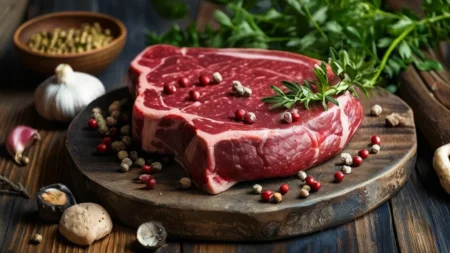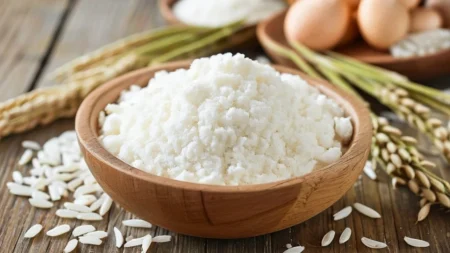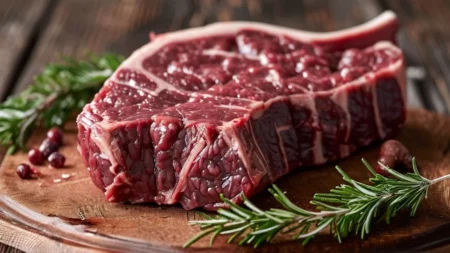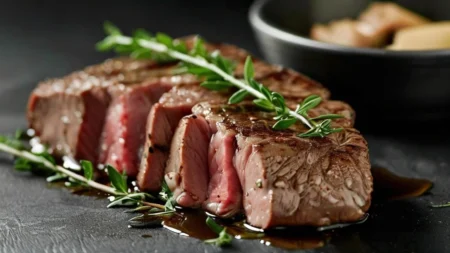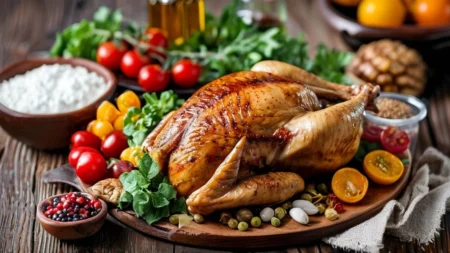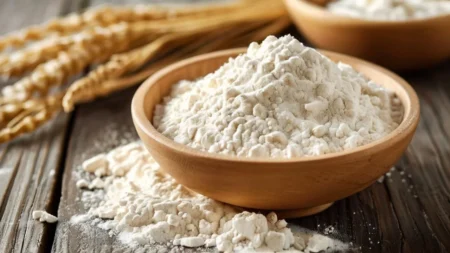Pork Shoulder: A Flavorful Cut Perfect for Slow Cooking
Key Takeaways:
- Pork shoulder is a versatile cut of meat known for its rich flavor and tenderness when cooked low and slow.
- It’s an excellent source of protein, B vitamins, and essential minerals.
- Ideal for various cooking methods, pork shoulder can be used in a variety of dishes, from pulled pork to stews.
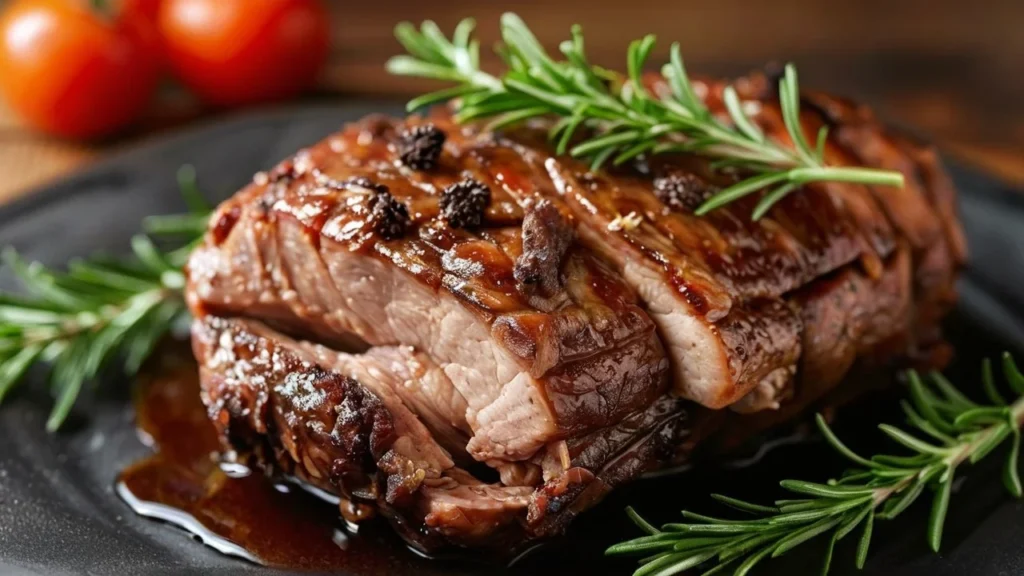
Nutritional Profile of Pork Shoulder
Pork shoulder, also known as pork butt, is rich in nutrients. Here’s a nutritional breakdown for 100 grams of cooked pork shoulder:
| Nutrient | Amount |
|---|---|
| Calories | 250 kcal |
| Protein | 25 grams |
| Total Fat | 18 grams |
| Saturated Fat | 6 grams |
| Carbohydrates | 0 grams |
| Vitamin B12 | 0.7 mcg (29% DV) |
| Thiamine (B1) | 0.8 mg (67% DV) |
| Niacin (B3) | 8 mg (50% DV) |
| Phosphorus | 220 mg (31% DV) |
| Selenium | 30 mcg (55% DV) |
| Zinc | 2 mg (18% DV) |
Rich in Protein
Pork shoulder is a great source of high-quality protein, essential for muscle growth, repair, and overall body function.
High in B Vitamins
This cut is particularly rich in B vitamins, including B12 and niacin, which help maintain energy levels and support metabolic processes.
Types of Pork Shoulder
Pork shoulder can be broken down into two main cuts, each with its unique characteristics:
| Type of Cut | Description | Best Cooking Methods |
|---|---|---|
| Boston Butt | Comes from the upper part of the shoulder; well-marbled and tender. | Slow-roasting, braising, smoking |
| Picnic Shoulder | Contains more fat and connective tissue, often tougher. | Slow-cooking, braising, stewing |
Boston Butt
Boston butt is a popular choice for pulled pork due to its high fat content and tenderness when cooked. It holds flavor well and benefits from long cooking times.
Picnic Shoulder
Picnic shoulder is slightly tougher but can be equally flavorful when cooked slowly. It’s often used in stews or as a roast.
Health Benefits of Pork Shoulder
1. Supports Muscle Development
With its high protein content, pork shoulder is ideal for those looking to build or maintain muscle mass.
2. Provides Essential Nutrients
Pork shoulder contains important nutrients like phosphorus and selenium, which play key roles in bone health and antioxidant defense, respectively.
3. Rich Flavor Enhancer
The marbling of fat in pork shoulder not only enhances flavor but also contributes to the tenderness of the meat when slow-cooked, making it a satisfying addition to many dishes.
Best Cooking Methods for Pork Shoulder
1. Slow Cooking
Slow cooking is one of the best methods for preparing pork shoulder. This method allows the fat to render, resulting in juicy, tender meat. A slow cooker or Dutch oven is ideal for this technique.
2. Smoking
Smoking pork shoulder adds a depth of flavor that is hard to beat. The low heat and long cooking time help break down the connective tissue, yielding tender, pull-apart meat.
3. Braising
Braising involves cooking the pork shoulder in liquid at low temperatures. This method not only tenderizes the meat but also infuses it with flavors from the cooking liquid.
How to Make Pork Shoulder Healthier
Although pork shoulder is flavorful, there are ways to make it a healthier choice:
1. Trim Excess Fat
Before cooking, trim visible fat to reduce overall fat content while retaining the flavor that comes from marbling.
2. Opt for Fresh Herbs and Spices
Instead of relying on high-sodium marinades, use fresh herbs, spices, and citrus to enhance flavor without adding unnecessary sodium.
3. Pair with Healthy Sides
Serve pork shoulder with nutrient-dense sides, like steamed vegetables or whole grains, to create a balanced meal.
Popular Dishes Featuring Pork Shoulder
Pork shoulder is incredibly versatile and can be used in various delicious dishes:
| Dish | Description |
|---|---|
| Pulled Pork Sandwiches | Shredded pork shoulder served on a bun with barbecue sauce. |
| Pork Tacos | Flavorful pork shoulder shredded and served in tortillas with fresh toppings. |
| Pork Stew | A hearty stew featuring chunks of pork shoulder and vegetables. |
| Carnitas | Mexican-style pulled pork, typically cooked with citrus and spices. |
| Pork Adobo | A Filipino dish where pork shoulder is braised in soy sauce and vinegar. |
Pork Shoulder and Nutritional Considerations
High in Fat
Pork shoulder is relatively high in fat, particularly saturated fat. While this contributes to its flavor, moderation is key for those monitoring their fat intake.
Sodium Content
Many recipes call for sauces that can be high in sodium. To maintain heart health, look for lower-sodium alternatives or make your own sauces.
Portion Control
Due to its richness, controlling portion sizes is important. Serving with plenty of vegetables can help balance out the meal.
Conclusion
Pork shoulder is a flavorful and versatile cut of meat that shines when cooked slowly. It provides essential nutrients and is perfect for a variety of dishes, from pulled pork sandwiches to hearty stews. While it’s higher in fat than some other cuts, making informed cooking choices and pairing it with healthy sides can make it a delicious addition to a balanced diet.
FAQ
Q: What’s the best way to cook pork shoulder?
A: Slow cooking, smoking, and braising are the best methods to ensure tenderness and flavor.
Q: How long should I cook pork shoulder?
A: Cooking times vary depending on the method, but it typically takes 6-8 hours in a slow cooker or about 10-12 hours in a smoker at low temperatures.
Q: Can I make pork shoulder in the oven?
A: Yes, pork shoulder can be roasted in the oven. Cook it at a low temperature (around 300°F) for several hours until tender.
Q: Is pork shoulder healthy?
A: Pork shoulder can be part of a healthy diet when enjoyed in moderation and prepared mindfully, such as trimming excess fat and serving with healthy sides.
Q: What are some good side dishes for pork shoulder?
A: Good side dishes include coleslaw, roasted vegetables, or whole grain rice, which complement the rich flavors of the pork.





